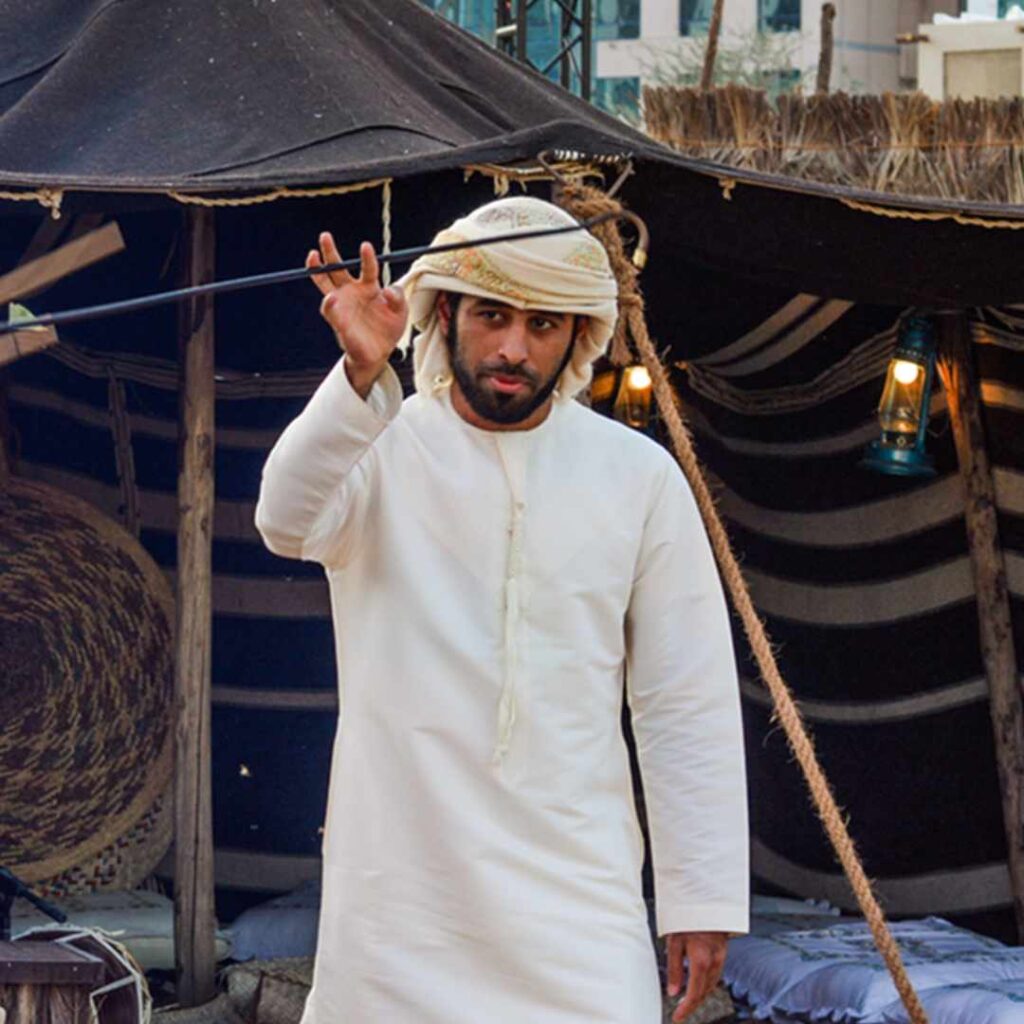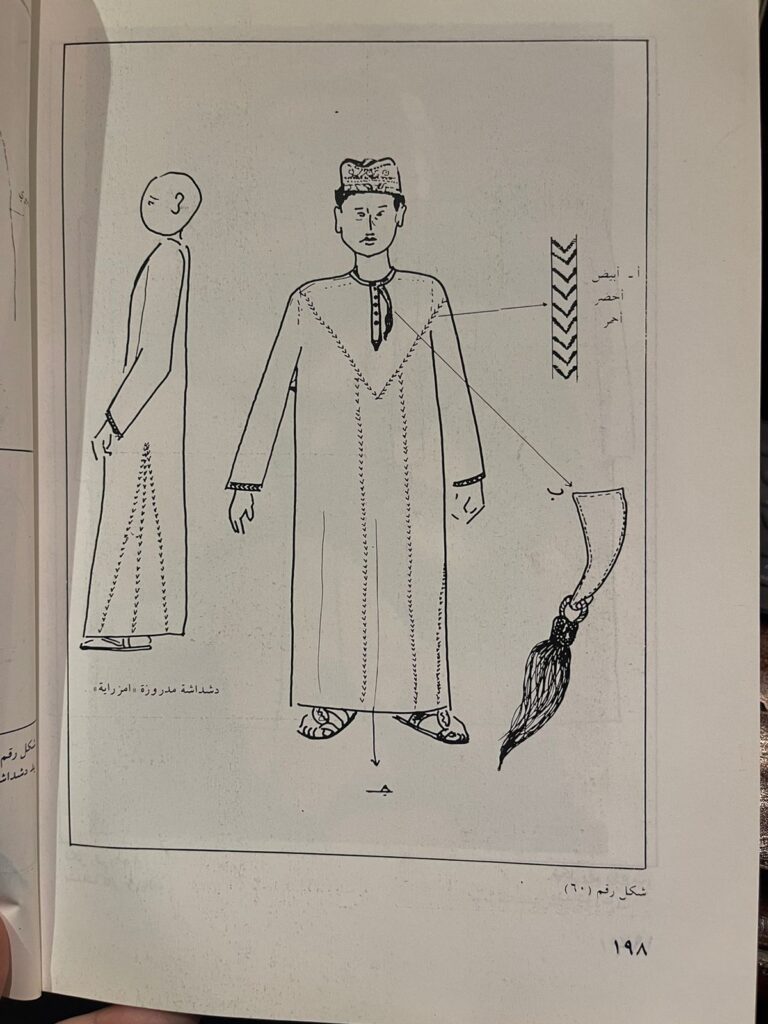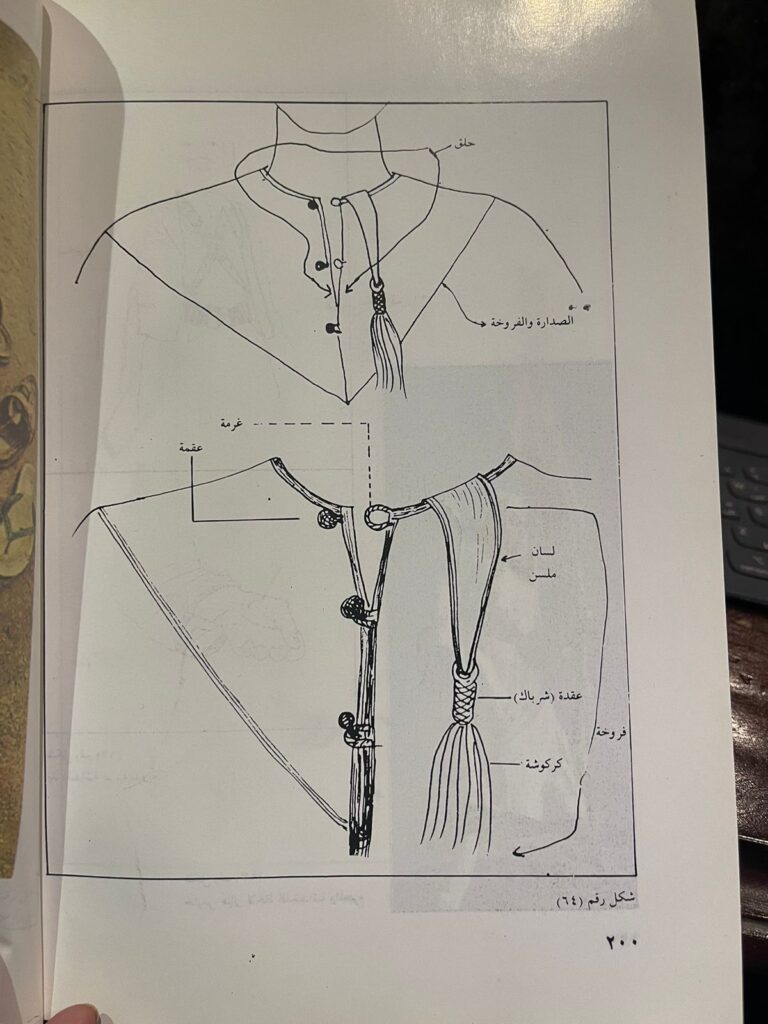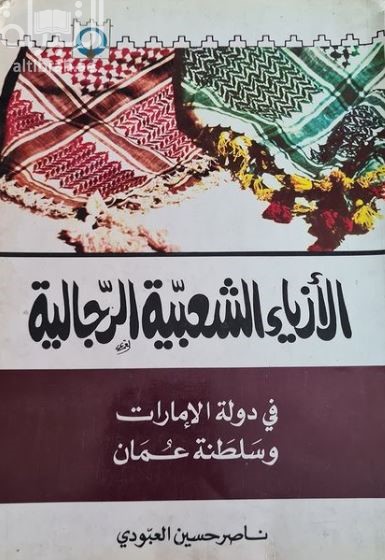In a previous post about the head cap (tarbush), we mentioned how the word tarbūshah is locally used in some parts of the UAE to refer to the decorative tassel (farukhah) or (karkushah) on the tunic (kandurah) or (dishdashah) worn by men.
Although the farukhah has become a defining characteristic of the modern Emirati kandurah, it has largely been neglected in both research and literature. In this blog post, we aim to shed light on its origins, history, and cultural significance by delving into its evolution. We will examine various theories regarding its purpose and trace its development alongside the Emirati kandurah. Through this short exploration, we hope to gain a clearer understanding of the farukhah’s past, present, and potential future within Emirati culture, thus contributing to the growing body of knowledge surrounding Emirati dress.
Traditional men’s dress in the UAE
In his book “Traditional Men’s Attire in the UAE and Oman,” Dr. Nasser Al Aboudi provides an analysis that traces the origins of the traditional dress worn by men in the UAE back to 300 years ago. Drawing on historical accounts that detail the social, political, and economic circumstances of the region and its neighbouring Gulf states, Dr. Al Aboudi posits that the attire’s introduction was likely influenced by the area’s climate. He further suggests that the kandurah’s continued usage can be attributed to its affordability and the lack of viable alternatives that are suitable for the region’s unique climate.
The Emirati kandurah
Before we delve into the farukhah, we must briefly examine the Emirati kandurah which features a collarless design and a comfortably loose fit that flows over the body in an A-line silhouette reaching the ankles. The sleeves maintain a consistent width from shoulder to wrist, accentuated by triangular gussets that seamlessly connect the body and sleeves. Adding a touch of refinement, some tunics (kanādīr) feature a delicately hanging tassel, known as the farukhah, adorning the rounded neckline.
What is the farukhah?
The term (farkhah) likely originates from (farkh, pl. firākh) meaning a young chick or a small version of a larger object. In the context of the kandurah, it refers to an ornament. The farukhah consists of an upper triangular fabric resembling a tongue (lsān) and a cascading tassel known as karkushah. Over time, the simple tassel evolved into a cluster of intricately braided threads with varying lengths. The farukhah is attached to the kandurah using the two-layered tongue lsan, secured by buttons. The lsan stretches from the neckline cascades down the front placket, and is cinched by a plastic button or decorative cotton ball (‘iqmah). The length of the farukhah can range from around 15 cm to over 30 cm, reaching below the navel area.
Early photographs from the pre-oil era in the UAE show primitive versions of the farukhah. Mostly, just a cluster of a few short threads tied together on the right side of the neckline of some kanadir. These diminutive ornaments are almost unrecognisable from the refined styles that emerged after the millennium.
The origin and purpose of the farukhah are both the subject of various theories. Some consider it purely decorative, while others believe Bedouins used it to swat away insects. There is even a legend that suggests travellers would scent their farukhah to evoke memories of home.
As an expert in the field, Dr. Al Aboudi has met and regularly interacted with known tailors in Sharjah, many of whom have since departed from this world. He recorded notable individuals including Mohammed Akbari, Hussein Abdul Rasool, Abadan Abdul Hussein, Ghuloom Karimi, Mohsen bin Abdullah, and Al-Mada.
Based on his records, Dr., Al Aboudi states that the farukhah, as we know it today, was not commonly used in Omani or Emirati tunics. The triangular portion or tongue (lsan) appeared in the 1960s, with the tassel (karkushah) added later in the 1970s. While some tailors used the lsan, others never incorporated the tassel (karkushah). The question remains: Where did it come from?
From bisht to kandurah?
According to Dr. Al Aboudi’s observations, the origins of the tassel (karkushah) can be traced back to its relative, the golden metal braid (gasab) found on the intricate embroidery (khwar) that adorns the sides of the central lapel (darbawiyah) on the outer cloak known as the bisht. Within this opulent embroidery, one can find exquisite tassels (‘amayil) meticulously crafted from the same lustrous metallic (zari) thread. An example of this can be explored in the digital archive of The Zay Initiative, showcasing the artistry of these intricate embellishments.
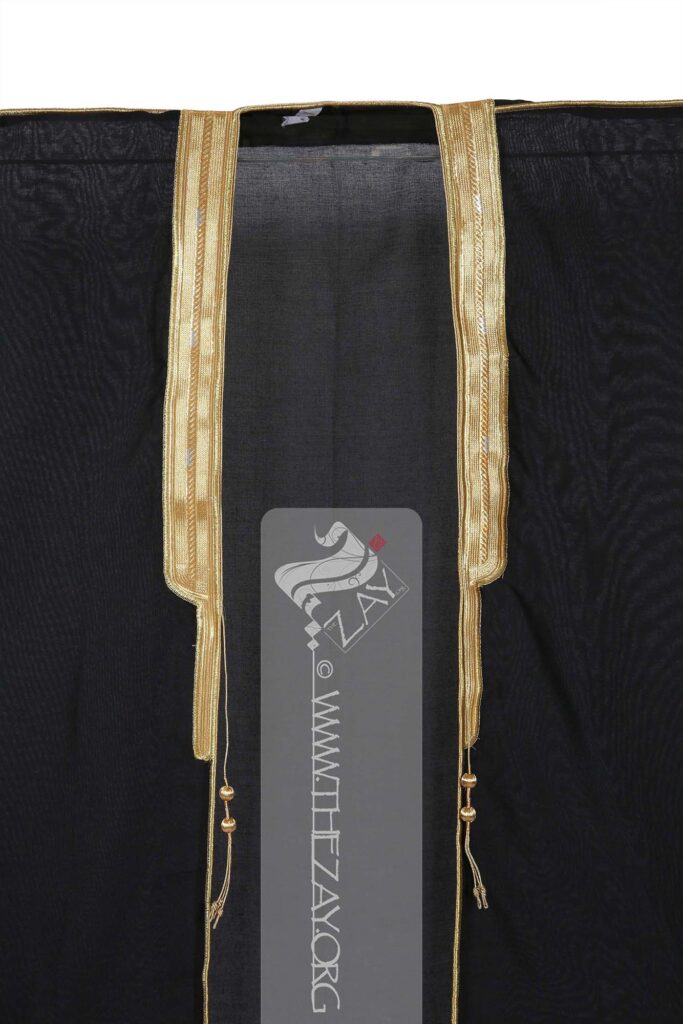
View in the Digital Archive
Dr. Al Aboudi speculates that in the 1970s, tailors from Asian countries such as Bangladesh, India, or Pakistan, perhaps unaware of the traditional significance, added the tassel as an embellishment to the tunic kandurah. Over time, this decorative trend gained popularity among young Emiratis, looking to express their individuality, becoming a cherished style statement. The Zay Collection showcases a remarkable 1979 Emirati kandurah featuring an elongated farukhah that gracefully extends down to the navel, showcasing the evolution of this aesthetic choice.
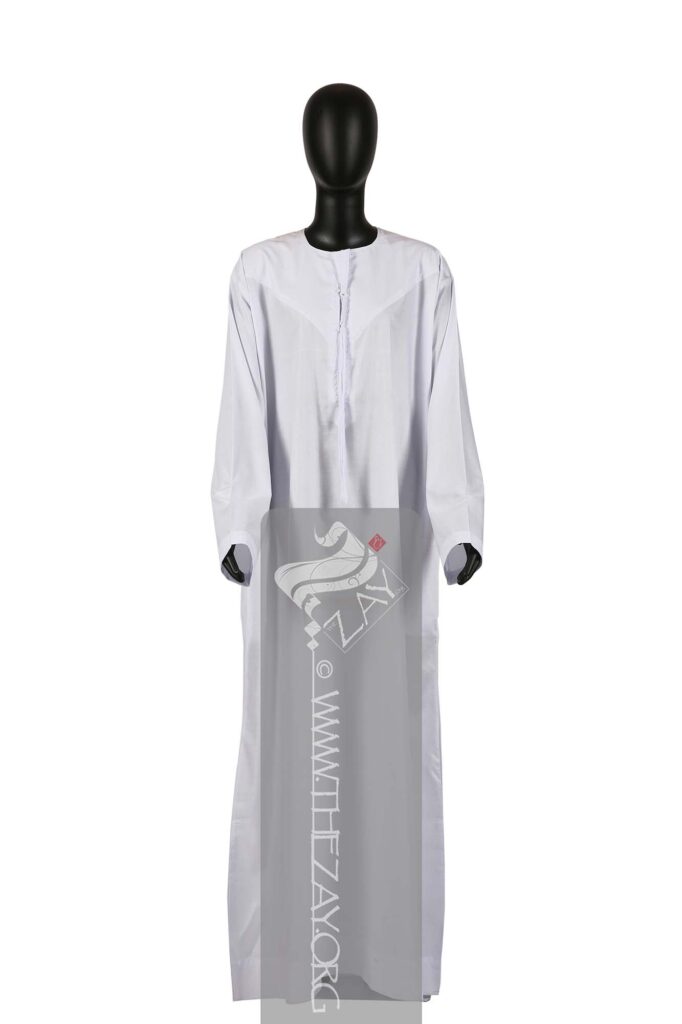
View in the Digital Archive
Moreover, it is worth considering that the UAE leadership’s post-millennial endeavour to identify and preserve traditional heritage may have inadvertently contributed to the elevation of the farukhah’s status. As these efforts sought to cultivate and promote cultural legacies, the farukhah became not only a cherished craft but also a cultural attraction.
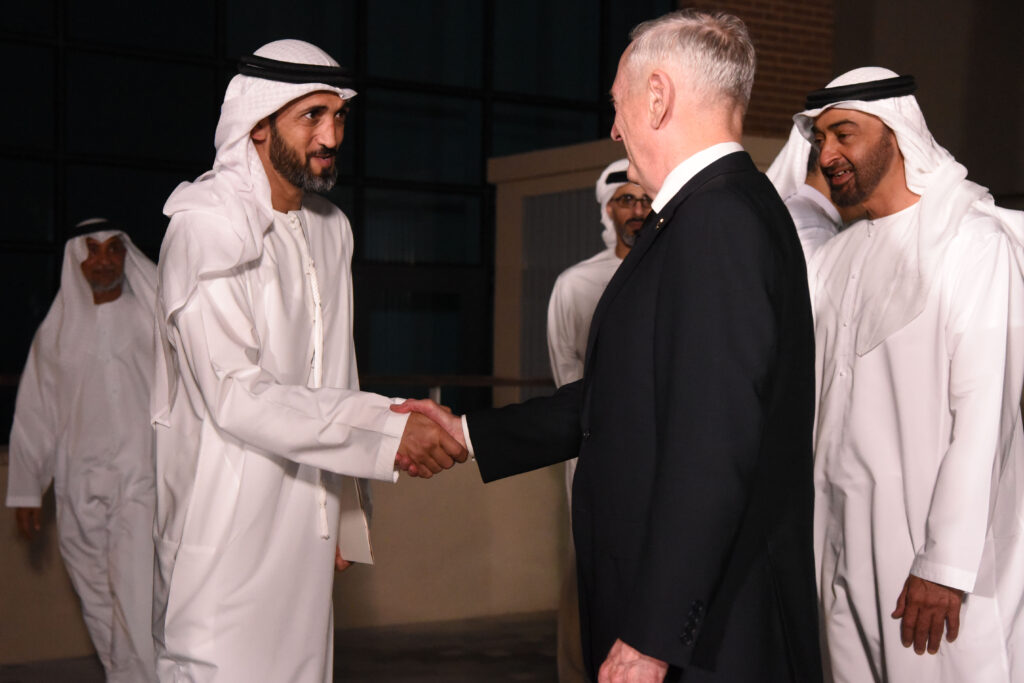
Emirati official greeting the U.S. Secretary of Defense in 2018 – source: flickr
The Significance of the farukhah today and into the future
While acknowledging that the tassel (farukhah) may not hold widespread significance in the history of Emirati attire, Dr. Al Aboudi emphasises the undeniable role of the tunic (kandurah) as a symbol of identity and heritage for Emirati men. In an increasingly globalised world with a significant expatriate population in the UAE, this traditional garment serves as a powerful reminder of Emirati belonging and connection to their cultural legacy.
In essence, the farukhah may exemplify how traditional clothing can organically evolve through serendipitous cultural exchange. Through this exploration of the farukhah’s short history in Emirati men’s dress, we hope to have shed some light on the tassel that is increasingly becoming an intrinsic part of it.
Share your thoughts and questions in the comments below, and make sure to subscribe to our newsletter for further insights into Arab dress and culture.
Acknowledgment:
We are grateful for the expertise of Dr. Nasser Al Aboudi, author of and his informative responses to questions posed by Dr. Reem Tariq El Mutwalli.
About Dr. Nasser Hussein Al Aboudi
Nasser Hussein Al Aboudi was born in 1955 in Sharjah, United Arab Emirates. He pursued higher education at the University of Baghdad, earning a bachelor’s degree in Ancient Archaeology in 1977. Throughout his career, Dr. Al Aboudi has been a prolific writer, publishing eight books and more than 105 studies and research papers in the fields of archaeology, heritage, and museums.
Dr. Al Aboudi has held various significant positions, including Director of the Ajman Information and Culture Office, and Head of the Archaeology Department in Dubai. Most recently, he served as the Director of Archaeology and Museums and was appointed as the Director of the Department of Archaeology and Heritage in the Sharjah Department of Culture and Information.
Among Dr. Al Aboudi’s published works are books covering topics such as the archaeology of Sharjah, traditional Emirati men’s clothing, studies on the UAE’s heritage and archaeology, and the Al Bidya Mosque. His contributions to the field have been widely recognised, and he has held memberships in various prestigious organisations related to history, heritage, and archaeology.
Sources:
- الأزياء عند العرب عبر العصور المتعاقبة – الدكتور عبد العزيز حميد صالح
- Omani Men’s National Dress: Displaying Personal Taste, Asserting National Identity – Aisa Martinez
- Mens Dress in the Arabian Peninsula: Historical and Present Perspectives
- Textiles and personal adornment in the Arabian Peninsula: papers from the special session of the Seminar for Arabian Studies held on 29 July 2016
- Thermal insulation and clothing area factors of typical Arabian Gulf clothing ensembles for males and females: measurements using thermal manikins
- The misrepresentation of Arab gulf men through costumes on stage and screen – Abdulmajeed Aldoukhi
- History of the kandura: how the traditional Emirati dress has evolved in the last 100 years
